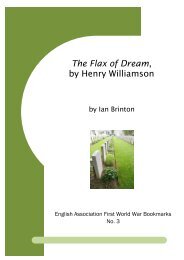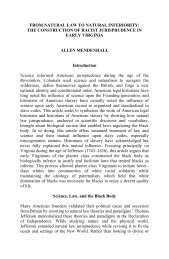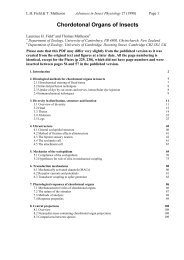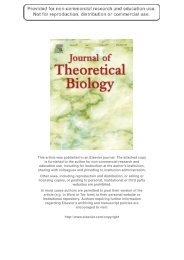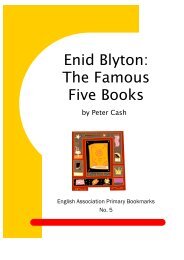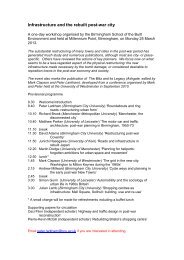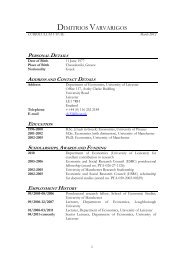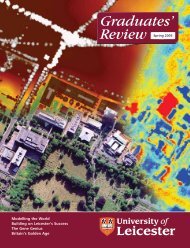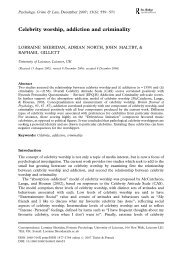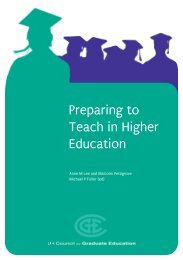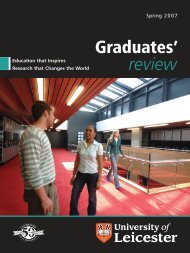2008 Graduates - University of Leicester
2008 Graduates - University of Leicester
2008 Graduates - University of Leicester
You also want an ePaper? Increase the reach of your titles
YUMPU automatically turns print PDFs into web optimized ePapers that Google loves.
Spring <strong>2008</strong><strong>Graduates</strong>’reviewEducation that InspiresResearch that Changes the World
2 GRADUATES’ REVIEW · SPRING <strong>2008</strong>ContentsPage 3An Introduction fromthe Vice-ChancellorPr<strong>of</strong>essor Robert BurgessPage 17Commitment Leadsto Highest HonourTaking responsibility for learningPage 4Fair Access for AllAspiring to a university educationPage 19The <strong>University</strong> <strong>of</strong><strong>Leicester</strong>A half-century <strong>of</strong> changePage 6A Window to theWorldPage 22<strong>University</strong> NewsHighlights <strong>of</strong> the past yearMedia – the great escapePage 9Going GreenPage 25Alumni NewsTurning over a new leafBringing graduates togetherPage 10Messing Aroundwith RealityPage 28Annual FundStudents make a case for supportStorm Thorgerson’s World <strong>of</strong>Music Graphic DesignPage 14Cancer Preventionand Food DerivativesIngredients <strong>of</strong> a healthy dietCOVER IMAGE: Folding Stars was designed by<strong>Leicester</strong> graduate Storm Thorgerson, for a songinspired by grief in Biffy Clyro’s album Puzzle (2007).© <strong>University</strong> <strong>of</strong> <strong>Leicester</strong> <strong>2008</strong><strong>University</strong> <strong>of</strong> <strong>Leicester</strong>, <strong>University</strong> Road, <strong>Leicester</strong> LE1 7RH.Email: alumni.relations@le.ac.ukThe Alumni Relations Website: For the latest alumni news, entries for the <strong>2008</strong>Personalia and obituary notices please visit our website: www.le.ac.uk/alumni
GRADUATES’ REVIEW · SPRING <strong>2008</strong> 3‘<strong>Leicester</strong> is a giant on the move’Introduction by Pr<strong>of</strong>essor Robert Burgess, Vice-ChancellorPr<strong>of</strong>essor Robert BurgessCelebrate <strong>Leicester</strong> Dayaims to provide an insightinto the work <strong>of</strong> the<strong>University</strong> through a day <strong>of</strong>fun, academic stimulationand entertainment for allthe family.As we reach the end <strong>of</strong> a year <strong>of</strong>celebrations to mark the 50th anniversary<strong>of</strong> the <strong>University</strong> it is useful to reflect onmany significant achievements.At the start <strong>of</strong> our celebrations inSeptember, The Times published a fourpagefeature on the <strong>University</strong> <strong>of</strong><strong>Leicester</strong>, declaring us an “award winninginstitution attracting top academics”.<strong>Leicester</strong>, it said, is “a giant on themove”. Naturally, we would agree andrecent months have demonstrated ourcontinual development as we have seenthe <strong>University</strong> rank top for studentsatisfaction in England amongst full-timestudents at mainstream universities. Ourscore <strong>of</strong> 4.4 out <strong>of</strong> 5 in the NationalStudent Survey is matched only by Oxfordon this measure. Our research also has,according to a study by Evidencepublished in The Guardian, the greatestimpact <strong>of</strong> any Midlands university and wehave the strongest record for teachingquality amongst Midlands’ universities.In this magazine you can read about some<strong>of</strong> the work that has led to theseachievements. For example, Pr<strong>of</strong>essorHelen Atkinson, Fellow <strong>of</strong> the RoyalAcademy <strong>of</strong> Engineering, and one <strong>of</strong> onlytwo women elected to the Academy lastyear, talks about her work leading<strong>Leicester</strong>’s Mechanics <strong>of</strong> MaterialsEngineering Group. Pr<strong>of</strong>essor YvonneJukes, newly arrived in our Department <strong>of</strong>Criminology, discusses her groundbreaking work looking at how prisonerswatch and consume television. In this issue<strong>of</strong> the Review you can also read <strong>of</strong> ourleading edge work with schoolchildrenfrom disadvantaged areas. Of the top 20research universities in England only one,<strong>Leicester</strong>, meets its Governmentbenchmarks for admissions from lowersocio-economic groups. Staff and studentambassadors work with young peoplefrom many areas to ensure that those withtalent are inspired to aim high and receivesupport to progress to university.If you haven’t visited the <strong>University</strong> in awhile you will be pleased to see how ourambitious £300m development plan istransforming our campus. Our new DavidWilson Library is open fully later this yearand our state-<strong>of</strong>-the-art John Foster Hall <strong>of</strong>Residence, on the site <strong>of</strong> the old VilliersHall, represents a new standard in studentand conference accommodation. However,the achievements we have made intransforming our estate would not havebeen possible without the generoussupport <strong>of</strong> our alumni. Over 1,420 havegiven a gift to support this work, many <strong>of</strong>whom are listed on pages 29-30. I havewritten to thank donors personally but Iwould also like to take this publicopportunity to thank them for their supportwhich is invaluable and truly appreciated.You will also be interested to know that onSaturday April 26 <strong>2008</strong> we are holdingCelebrate <strong>Leicester</strong> Day. This is a veryimportant date and aims to provide aninsight into the work <strong>of</strong> the <strong>University</strong>through a day <strong>of</strong> fun, academic stimulationand entertainment for all the family. Froman invasion <strong>of</strong> Vikings to explodingchemicals, from the search for extraterrestrial life to the state <strong>of</strong> Englishpr<strong>of</strong>essional football, my colleagues willlead over 150 different activities open toalumni and the public. There will beopportunities to take a look at our newlibrary, tour the campus, receive a BodyMOT and pick up a bestseller in our newbookshop. Supervised children are welcomeand there are rides and activities especiallyfor them so do please come along and tellall your friends and family about this specialday in our celebratory year.As you read this magazine I hope you feelgreat pride in your <strong>University</strong>. A <strong>University</strong><strong>of</strong> 19,500 students with a turnover <strong>of</strong>£185m may be very different to the<strong>Leicester</strong> you knew but our values andcommitment to excellence remain. I amvery confident that after 85 years <strong>of</strong>academic activity, 50 <strong>of</strong> which have nowbeen as a <strong>University</strong>, we are poised forfurther success and will grow ever stronger.
4 GRADUATES’ REVIEW · SPRING 2007 <strong>2008</strong>Fair AccessforAllOf the UK’s top 20 research universities, only one, <strong>Leicester</strong>,meets Government benchmarks for supporting participationfrom lower socio-economic groups.Recentvisitorsto the<strong>University</strong>’scampus may havenoticed somestrange goings-on.From sixth formerslying on the carpet in thefoyer <strong>of</strong> the Fielding JohnsonBuilding to primary students‘hiding’ in the sculptures and statuesaround the grounds.The <strong>University</strong> has been playing host tothe next generation <strong>of</strong> HE (HigherEducation) students in its goal <strong>of</strong> raisingawareness <strong>of</strong> and aspirations to auniversity education.In a typical year the <strong>University</strong> willwelcome over 20,000 young people fromprimary and secondary schools to a wholerange <strong>of</strong> activities led by staff fromCentres <strong>of</strong> Excellence in Teaching andLearning (CETLs), Departments, Schooland College Services and the BotanicGarden. Activities include SummerSchools, <strong>University</strong> Experience Days,Dynamic DNA, Masterclasses, and a range<strong>of</strong> curriculum-related activities at the<strong>University</strong>’s Botanic Garden.The widening participation agenda andHEFCE targeted guidelines haveencouraged universities to questionwhat barriers able students from underrepresentedgroups face in getting auniversity education. <strong>Leicester</strong> hasdeveloped activities that dispel some <strong>of</strong>the commonly held myths and attitudesto university. Building on this successshould ensure healthy recruitment <strong>of</strong>able students from all backgrounds infuture years.In addition to raising a generalawareness <strong>of</strong> higher education, many<strong>of</strong> the activities focus on subjectspecific attainment and interest raising.Research shows that attendance at asummer school or masterclass can havea positive effect on a young person’sfuture choices. The <strong>University</strong> hasundergraduate Student Ambassadorswho have personally experienced atleast one on-campus outreach eventbefore applying to study here and theevidence suggests that this is agrowing trend.The most successful on-campusvisits always include a tour<strong>of</strong> the campus andmeeting StudentAmbassadorsto hear aboutuniversity lifefirst-hand.Studentsattending <strong>University</strong>Experience days alsoget the chance to‘graduate’ and experience what it feelslike to wear the <strong>University</strong> <strong>of</strong> <strong>Leicester</strong>graduation outfit – it’s encouraging tosee them take home graduationpictures on their mobile phones as areminder <strong>of</strong> this special day.Although the <strong>University</strong> aims to workwith as wide a range <strong>of</strong> schools aspossible, a focus on some key localschools has also reaped rewards, such asthe links developed with the newSamworth Enterprise Academy. StudentAmbassadors and staff have createdopportunities to meet parents and pupilsat a series <strong>of</strong> roadshows, as well as a visitby the whole <strong>of</strong> Year 6 to the campus inFebruary to experience subject-relatedactivities in Physics and Archaeology.In addition to its general outreach workthe <strong>University</strong> has also engaged with anumber <strong>of</strong> other key wideningparticipation agendas including ‘LookedAfter Children’, supporting localactivities, co-hosting an annual nonresidentialsummer school for youngpeople in care, and assisting the
GRADUATES’ REVIEW · SPRING <strong>2008</strong> 5<strong>University</strong> to gain the Frank Buttle TrustQuality Mark for Care Leavers in HE.Staff from the <strong>University</strong> also work withother local HEIs in providing information,advice and guidance for students withdisabilities including a very successful‘Supporting Students with Dyslexia inHE’ event which runs every year.<strong>Leicester</strong> is also engaging the parents <strong>of</strong>students from under-represented groupsarranging to visit the campus andproviding opportunities to meetuniversity students themselves in thehope that this will encourage a greaterdialogue about university as a viable andaffordable option.The <strong>University</strong> takes its involvement withlearners seriously, particularly those fromdisadvantaged and low participationbackgrounds. It is committed toproviding positive opportunities forwidening participation students to visitthe campus, meet university studentsand staff, and develop an interest insubjects <strong>of</strong>fered at degree level. So nexttime you see a face appearing frombehind ‘Souls’ on the Fielding Johnsonlawn or a group posing around ‘The Eye<strong>of</strong> Time’ sundial there might just bemore to it than meets the eye.For information about the <strong>University</strong>’sWidening Participation activity, contactJean Baxter, Head <strong>of</strong> School and CollegeServices at jb74@le.ac.ukStudent attending ‘Dynamic DNA’ activitiesat the <strong>University</strong><strong>University</strong> Experience Days• Aimed at Year 10 students in <strong>Leicester</strong> City and <strong>Leicester</strong>shire• Students spend the day on campus supervised by a Student Ambassador• Based on the theme ‘Work, Rest and Play’ school students find out about the lives <strong>of</strong> arange <strong>of</strong> undergraduate and postgraduate students• In 2006-7 over 1,000 students attended <strong>University</strong> <strong>of</strong> <strong>Leicester</strong> UE days andover 96% felt they had learnt what university is likeStudent Ambassadors• Work on Open Days• Support Widening Participation work on and <strong>of</strong>f campus• Receive training in: widening participation; child protection and safeguarding;group work; communication skills• Feedback forms at events help Ambassadors to reflect on their work• Increasingly Ambassadors represent the <strong>University</strong> at school/college parents’evenings and at HE eventsThe Botanic Garden• This year over 2,400 students (from reception to Year 13) from40 schools and colleges have taken part in activities at theBotanic Garden• Over 800 students (Year 1-6) attended the ‘Journeys toChristmas’ event in December 2007, following three different‘star’ trails around the garden• Over 600 attended the ‘Whole World Cake’ which supportsthe Key Stages 1 and 2 Citizenship curriculumGENIE - Genetics Education Networking for Innovation and Excellence• The GENIE CETL’s ‘Dynamic DNA’ programme isan annual event• In 2007 over 600 students took part in a host <strong>of</strong>‘Dynamic DNA’ activities over two days including‘Go Bananas’ extracting DNA from a banana, and‘One in a Million’ looking at various genetic traitsand their occurrence in <strong>Leicester</strong>shireSummer Schools• Since 2000, Summer Schools have involved over 1,000 students from the EastMidlands region• Students have access to a full programme <strong>of</strong> sports and entertainment – includingten-pin bowling, access to the <strong>University</strong>’s sports facilities, Sambawamba drum anddance and carnival costume workshops, a celebration dinner and disco• <strong>University</strong> mentors provide an invaluable link between the social and academic sides <strong>of</strong>university life as well as programme support• Residential Summer Schools have included: ‘Chemistry: The Next Generation’; ‘AwesomeEngineering’; ‘Media, Society and You’; ‘Science - It’s Big and It’s Clever’; ‘Science Rocks’;‘Amazing Space’; ‘Chemistry: The Next Generation’; ‘Engineer your Future’; ‘GENIE – Allabout DNA and Genetics’
6 GRADUATES’ REVIEW · SPRING <strong>2008</strong>TV and the internet are bringing the outside in. It is a revolution that ischanging the way prisoners see themselves – and view the world outside.For <strong>University</strong> <strong>of</strong> <strong>Leicester</strong> Pr<strong>of</strong>essorYvonne Jewkes, <strong>of</strong> the renownedDepartment <strong>of</strong> Criminology, watchingTV won’t be quite the same again.She has studied the way prisoners watchTV – or ‘consume the media’ to useacademic parlance – and it is not quitethe same as you and I.She said: “Although many wouldregard television as a medium <strong>of</strong>transparency and openness, and theprison as an archetypal example <strong>of</strong>closure and secrecy, I found therelationship between the two to bemuch more subtle and complex thanthis – certainly the popular press’s viewthat in-cell TV is a perk that encouragesprisoners to while away their time inpurposeless inactivity is pretty wide <strong>of</strong>the mark.“While it was not particularlysurprising to find that prisoners’ use<strong>of</strong> media is shaped by the coerciverequirements <strong>of</strong> the institution, it wasinteresting to discover how someindividuals used media texts andtechnologies as a source <strong>of</strong>empowerment and as a resource tohelp them adapt to life in prison,adopt an acceptable identity, andenhance their sense <strong>of</strong> self.“The very personal meanings andmemories that individual prisonersattached to particular TV shows, radioprogrammes or songs left a lastingimpression on me.”The paradox <strong>of</strong> prisons iscentral to the work <strong>of</strong> Yvonneas she juxtaposes the role <strong>of</strong>the media as advocates <strong>of</strong>freedom and transparencywith that <strong>of</strong> prisons asarchetypal examples <strong>of</strong>closure and secrecy.
GRADUATES’ REVIEW · SPRING <strong>2008</strong> 7Yvonne’s research has been concernedwith the relationship between mediaconsumption and power relations inprison. The research was conducted overa period when in-cell television was beingdebated, piloted, rejected (when MichaelHoward was Home Secretary) and then,eventually, introduced as an earnedprivilege across most <strong>of</strong> the prison estate.“The Internet has changed the lives <strong>of</strong> all <strong>of</strong> us for thebetter; certainly, as an academic, it is hard to envisagehow much more difficult and time-consuming it used tobe to access books, find obscure journal articles, or docollaborative research with colleagues elsewhere in theworld before its arrival.”Now she is developing and broadeningthis area <strong>of</strong> interest to the study <strong>of</strong>Internet access in prisons.She said: “Currently only seven prisonsallow inmates access to the Internet, andit is heavily restricted and regulated. It isnot difficult to imagine how great theimpact <strong>of</strong> ‘new’ media technologies suchas the Internet could be on theexperience <strong>of</strong> imprisonment. In theirability to liberate users from physicaltime and place, and to bring the outsideinside, the potential benefits <strong>of</strong>computer-mediated communications toprisoners are incalculable.“In practical terms, access to computers,email and the Internet would allow usersin prison to interact with potentialemployers, public sector organisations thatmight help with particular issues such ashousing prior to release, and increasedcontact with lawyers. The Internet couldbe an immensely valuable tool for thePrison Service in handling fragmented andfragile relationships, would enableprisoners to keep in contact with theirchildren and other family members,and could also provide prisons witha wider range <strong>of</strong> resources fordelivering effective courses.“This has become an especially pressingproblem since the biggest provider <strong>of</strong>degree courses in prisons moved to onlinedelivery a couple <strong>of</strong> years ago. Not onlydoes the lack <strong>of</strong> Internet access precludedegree level study, but many prisoners arenot allowed to possess CD-ROMs or DVDsbecause the discs are considered potentialweapons for assault or self-harm.Consequently, they have to make do withsimulated tutorials that are loaded ontotheir computers rather than the real thing.”Yvonne became interested in the Internetand cyber crime simply as an extension <strong>of</strong>her work in the area <strong>of</strong> media and crime.She said: “Ten years ago there were veryfew criminologists who were researchingor writing about the cyber worldand, somewhat surprisingly,this is still the casealthough there are a fewmore <strong>of</strong> us now.“But online crime is still absent frommost major criminology textbooks whichI believe is an omission given theincreasing number <strong>of</strong> high-pr<strong>of</strong>ile,salaciously-reported Internet <strong>of</strong>fencesthat have come to public attention viathe pages <strong>of</strong> the popular press.“I can’t claim to be an expert when itcomes to the technology I’m moreinterested in the social impacts <strong>of</strong> theInternet. I’ve also written quiteextensively about the policing <strong>of</strong> cybercrimes and the particular problemsassociated with the regulation andpolicing <strong>of</strong> abusive images <strong>of</strong> children onthe Internet.<strong>Leicester</strong> Prison. Image courtesy <strong>of</strong>http://jonathan.rawle.org/gallery/using/
8 GRADUATES’ REVIEW · SPRING <strong>2008</strong>“In general though, I’m an optimistwhen it comes to computermediatedcommunications. Theconstant drip <strong>of</strong> frankly astonishingstories about the Internet’s potentialto corrupt, fed to us by a popularmedia baying for tougher laws todeal with cyber-<strong>of</strong>fenders, has to beput into perspective.”It is now fairly well established thatmedia are integral to how we makesense <strong>of</strong> the world, and thatmisrepresentations concerning theextent <strong>of</strong> certain types <strong>of</strong> crime andthe effectiveness <strong>of</strong> the criminaljustice system can create a skewedpicture <strong>of</strong> crime and punishment. Inher book Media and Crime (2004,Sage) Yvonne attempted to bringtogether the literatures and keytheoretical approaches from the tw<strong>of</strong>ields, and aims to reflect thesymbiotic relationship betweenmedia and crime which, after all, aretwo <strong>of</strong> the most pervasive features <strong>of</strong>contemporary life.Her combined research interests also ledto her founding a new academic journalin 2006 with colleagues in London(Dr Chris Greer, City <strong>University</strong>) and theUnited States (Pr<strong>of</strong>essor Jeff Ferrell,Texas Christian <strong>University</strong>). Crime,Media, Culture: An International Journalis published by Sage(http://cmc.sagepub.com) and isintended for those researchers whowork at the intersections <strong>of</strong>criminological and cultural inquiry. Itpromotes a broad cross-disciplinaryunderstanding <strong>of</strong> the relationshipbetween crime, criminal justice, mediaand culture, and “the journal stronglyencourages graduate students to submittheir work – not only full-length articlesbut also shorter research notes whichcan be more along the lines <strong>of</strong> ‘work inprogress’.” Yvonne was delighted thatin 2006 CMC received the prestigiousAssociation <strong>of</strong> Learned and Pr<strong>of</strong>essionalSociety Publishers/ Charlesworth Awardfor ‘Best New Journal.’She has recently published threebooks on imprisonment - Handbookon Prisons (2007, Willan), Dictionary<strong>of</strong> Prisons and Punishment, withJamie Bennett (Willan, <strong>2008</strong>) andPrison Readings, with HelenJohnston (Willan, 2006). Yvonne iscurrently working on a revisedsecond edition <strong>of</strong> Media and Crime(Sage) and is also producing for Sagetwo major three-volume works onPrisons and Punishment and Crimeand Media. This year she also hopesto bid for research funding to carryout a study <strong>of</strong> prison architectureand design, and the impact theyhave on the lives <strong>of</strong> prisoners andprison staff.She said: “The theme that brings allmy research interests together andgives it some kind <strong>of</strong> coherence isan interest in identity: howmasculinity is ‘performed’ in men’sprisons; how lifers manage theiridentity through a disrupted lifecourse; the possibilities thatprisoners could nurture theiridentities as parents, partners,skilled workers, students, etc, if theywere allowed access to the Internet;how new communicationtechnologies permit individuals tocreate, transform, play with, or stealidentities; the extent to whichprison design influences the lives <strong>of</strong>prisoners, prison staff, and those inthe community in which the prisonis located. I have a sociologicalimagination which underpins andinforms all my academic output.”Yvonne Jewkes joined the Department<strong>of</strong> Criminology in November 2007. Priorto this she was Reader in Criminology atthe Open <strong>University</strong>.She said: “Being appointed Pr<strong>of</strong>essor <strong>of</strong>Criminology at the <strong>University</strong> <strong>of</strong> <strong>Leicester</strong>is a huge honour for me and a particularthrill as it was here that I started myacademic career. I studied for my Mastersdegree in Mass Communications Researchat the <strong>University</strong> <strong>of</strong> <strong>Leicester</strong> in 1989. Ihadn’t thought about becoming anacademic but I saw a research postadvertised at the Centre for the Study <strong>of</strong>Public Order (now the Department <strong>of</strong>Criminology) so I went for it and it washere that my interest in criminologystarted to develop. It was rather a baptism<strong>of</strong> fire for a recent graduate – my firstexperience <strong>of</strong> teaching was on the MAprogrammes in Policing and Public Orderand the vast majority <strong>of</strong> our students werefrom the criminal justice pr<strong>of</strong>essions,including many fairly senior police <strong>of</strong>ficers.I was also the designated ‘media’specialist within the department whichentailed everything from teaching aboutmedia constructions <strong>of</strong> public disorder, toproducing a satellite TV programme aboutpolicing as part <strong>of</strong> a pan-Europeandistance learning initiative.”Yvonne has also taught Media Studiesat the former <strong>Leicester</strong> Polytechnic(now De Montfort <strong>University</strong>) andgained her PhD from the Institute <strong>of</strong>Criminology at Cambridge.
GRADUATES’ REVIEW · SPRING <strong>2008</strong> 9GOINGGREENdoes not cost the EarthThe <strong>University</strong> <strong>of</strong> <strong>Leicester</strong> stageda huge environmental festivalfrom 15-19 October. ‘Big GreenWeek‘ engaged staff and studentsand raised awareness <strong>of</strong>environmental issues at the <strong>University</strong>campus. It demonstrated how to'green' personal lifestyles. Before andduring the week, staff and studentsmade 1,286 pledges, committingthemselves to a small lifestyle changethat will benefit the environment.Staff member, Kerry Glover pledgedto “continue to use public transportto get to work and try to rememberto take reuseable carrier bags with mewhen I go shopping.” Currentstudent, Ali Craft, aimed to “try andeat only local meat and buy moreethical clothes”.Thanks to the <strong>University</strong>’sEnvironment Team, who spearheadedthe Big Green Week, the <strong>University</strong>has pledged to reduce its annualwaste by 600 tonnes this year,employ a dedicated Travel Coordinatorto support greenmethods <strong>of</strong> transport and toachieve fair-trade status.
GRADUATES’ REVIEW · SPRING <strong>2008</strong> 11If you don’t think you know <strong>Leicester</strong> graduateStorm Thorgerson, then think again. If you’ve ever lookedat an album cover <strong>of</strong> Pink Floyd, or Led Zeppelin, Muse,10cc, The Mars Volta, Peter Gabriel, The Cranberries,Deepest Blue, Alan Parsons or The Catherine Wheel,among many others, then the chances are you’re at leastfamiliar with Storm Thorgerson’s work.“I hang around musicians is what I do,”he writes in his book Taken by Storm –The album art <strong>of</strong> Storm Thorgerson(Omnibus Press). Clearly that is animportant part <strong>of</strong> what he does, butequally clearly, there is a great deal moreto designing album covers than that.Now a photographer, graphic designerand artist associated with some <strong>of</strong> thebiggest names from the popular musicculture from the 1970s onwards, backin 1963 Storm was an English andPhilosophy undergraduate at the<strong>University</strong> <strong>of</strong> <strong>Leicester</strong>.“I had a great time at <strong>Leicester</strong>,” hesaid. “I made three friends whom I stillhave and I thoroughly enjoyed it. TheEnglish course was excellent, especiallythe American Studies part. There wasan active film club and social calendar.I have excellent memories <strong>of</strong> <strong>Leicester</strong>.“I was delighted to go there, butscared too, because <strong>of</strong> leaving myhome town, which was also a goodplace to be. That was Cambridge, andit was a great town to grow up in. Iwas reluctant to leave all my friends,but I knew it was the right and properway to move on. So I was relieved tohave a good time in <strong>Leicester</strong>, too. Noteveryone does have a great time duringtheir student years.”Tearing himself away from <strong>Leicester</strong> in1966, Storm took an MA in Film andTV at the Royal College <strong>of</strong> Art inLondon, which he also enjoyed,before founding Hipgnosis withAubrey Powell.The graphic design studio specialised increative photography associated with themusic business and he very soon foundhimself designing album covers for artistslike Pink Floyd, Led Zeppelin, Genesis,Black Sabbath and Paul McCartney.“My career came about by accident,” hesaid, surprisingly. “Pink Floyd had goneto the same school in Cambridge as me.They asked a mutual friend to do acover for them and he declined. Ihappened to be listening at the doorand said, ‘I’ll do that’. Pink Floyd didn’twant to use a record company designer.They wanted to be more independent,in control. They thought they might aswell let me do it as anyone else. Fools.”Not such fools, it seems, since thepartnership has weathered forty yearsand is highly successful.Then, he says, he got lucky. “Luck hasan awful lot to do with this. WorkEye to Eye – Pink Floyd (2003)begets work. Sometimes when youwork for one musician you get to workfor another if you’re seen to be goodenough at doing it.”Work for Pink Floyd led to work for arecord company and via WishboneAsh’s manager to an album calledArgos, which Led Zeppelin saw andliked. Working with musicians rapidlybecame Storm Thorgerson’s speciality.“The music is the starting point for alldesign ideas and we played it overand over again in varyingcircumstances,” he writes in Taken byStorm, in relation to the CD front forCatherine Wheel’s Chrome. “We readand re-read the lyrics. And we talked,scribbled, thought hard, andgradually accumulated snippets,doodles and phrases which evolvedby further discussion and thinkinginto more concrete ideas andrecognisable sketches.”
12 GRADUATES’ REVIEW · SPRING <strong>2008</strong>Chrome – Catherine Wheel (1993)It doesn’t matter, he insists, whetherhe likes the music or not. Much <strong>of</strong> ithe does like, but that’s simply notrelevant. “Liking doesn’t haveanything to do with your ability tointerpret it. What we had to do wasexpress a band’s philosophy. Theiroutlook, preoccupations, obsession,the subject matter, how they woulddescribe themselves. We had tocapture their spirit in a visual.Sometimes it worked and sometimesnot – mostly it worked, <strong>of</strong> course, orwe wouldn’t still be in business.”Much <strong>of</strong> his work questions reality,makes the viewer look twice, eitherbecause an apparently ordinary sceneturns out to be quite extraordinary, orbecause <strong>of</strong> the bizarre juxtaposition <strong>of</strong>images. This is very much what heaims to do, to “get the viewer to lookagain, as they might listen to themusic again, trying to persuade,invite, seduce, beguile a person intolooking again.“A painter might do it through the wayhe paints rather than what he paints,”he explained. “A photographer can’t dothat, it has to be what you do ratherthan how you do it. Photography is a‘cold’ medium, quite mechanical.“We use photography completelydifferently from most photographers. Wealways contrive events, usually set in somestrange place. I’m sometimes calledsurrealist, but I don’t think <strong>of</strong> myself thatway. Some images are just funny, othersare sculptures and some are so amazingto make that I couldn’t bear to leave themthere or no one would ever see them.Some are like land art, some like actualevents, others involve actors or models.”Generally they are photographed in situ,not the result <strong>of</strong> a computer mock-up.This is true, whether they are <strong>of</strong> 700beds on a sea shore (Pink Floyd, AMomentary Lapse <strong>of</strong> Reason); 20wooden telegraph poles incongruouslyspanning across a farmer’s field, eachwith a person on the top (Gentlemenwithout Weapons, Transmissions); or anice sculpture <strong>of</strong> a swan in Death Valley,the hottest place on Earth (Blinker theStar, August Everywhere).This doesn’t make for easy assignments,as demonstrated by the ice swanincident described in Taken by Storm.“We found Gus, an ice-sculptor, over60 but ever charming and resourceful,but even he couldn’t prevent the icetruck from leaking, and couldn’t preventpunctures, and couldn’t envisage howrapidly the swan would melt, especiallyabove its neck. The virtue <strong>of</strong> doing it forreal was that the incandescent quality<strong>of</strong> the light bouncing around inside theice swan was sustained, and would nothave been nearly as good if we’d doneit as a comp in the computer.”In the 1980s Storm tried his hand atdirecting music videos, but he found it avery different world and feels he wasn’tvery good at it, though the Pink Floyd
GRADUATES’ REVIEW · SPRING <strong>2008</strong> 13Stomp 442 – Anthrax (1995)The Dark Side <strong>of</strong> the Moon – Pink Floyd (1973)video, Learning to Fly won Best DirectorAward at the American Billboard Awards.He also directed commercials, includingone for Tennants lager, One Great Thing,which won The Golden Rose in Scotland.Two television documentaries followed inthe early 1990s, the Art <strong>of</strong> Tripping forChannel 4, on artists and drugs, and thescience documentary Rubber Universe forEquinox. He has also designed logos forbands, including Dream Theater, bookcovers, including Douglas Adams, and T-shirts, including for Bruce Dickinson.Pieces <strong>of</strong> Eight – Styx (1978)Sentient Stardust – Marsha Swanson (2007)But his heart lies, it seems, in designingalbum covers. Perhaps we should give thelast word to Storm himself, again fromTaken by Storm “Everyone likes music <strong>of</strong>some kind or another, from grannies toguardsmen, from pubescents topoliticians. Music is intrinsically a goodthing like trees…one <strong>of</strong> the wondrousthings on this planet. Working for musicfeels relatively clean and wholesome, ifnot spiritually satisfying.”Storm Thorgerson’s work can be seen at: www.stormthorgerson.com/Album CoversThe Dark Side <strong>of</strong> the Moon – Pink Floyd (1973)Stomp 442 – Anthrax (1995)Folding Stars – song from the album Puzzle by Biffy Clyro (2007) (Front Cover)Tree <strong>of</strong> Half Life – Pink Floyd (2003)Eye to Eye – Pink Floyd (2003)Chrome – Catherine Wheel (1993)Pieces <strong>of</strong> Eight – Styx (1978)Sentient Stardust – Marsha Swanson (2007)
14 GRADUATES’ REVIEW · SPRING <strong>2008</strong>Leading Researchin cancer preventionf anddderivativesIf only we were all to eat enough <strong>of</strong> the right sort <strong>of</strong>fruit and vegetables every day we would almostcertainly be less likely to suffer fromcertain cancers.Simple as this sounds, it is difficult to persuade people to change to ahealthier lifestyle, and researchers into cancer prevention at the <strong>University</strong><strong>of</strong> <strong>Leicester</strong> are investigating pills derived from foods that are believed toprevent cancer. Work they have already done with laboratory models suggeststhe pills, too, could be effective.Over the past decade, the <strong>University</strong> <strong>of</strong> <strong>Leicester</strong> Department <strong>of</strong> CancerStudies and Molecular Medicine has become a world leader in research intochemoprevention (stopping cells becoming malignant), using substancesderived from food to prevent or slow down breast, colon and prostate cancer.
GRADUATES’ REVIEW · SPRING <strong>2008</strong> 15Cancer cells: (l) Fluorescent labelling <strong>of</strong> DNA markers from the bowel wall; (r) cell stained with fluorescent antibodies to show different cell componentsResearch led by Pr<strong>of</strong>essors Andy Gescherand Will Steward (head <strong>of</strong> the<strong>University</strong>’s Department <strong>of</strong> CancerStudies and Molecular Medicine) looks athow food-derived substances interferewith developing cancer cells, how theyget into the circulation and reach thecancer tissue that is targeted, and howlong they remain in the humanorganism. Their research results havebeen widely reported around the world.Chemoprevention studies into diet-derivedsubstances at <strong>Leicester</strong> began in 2000with the study <strong>of</strong> the curry constituentcurcumin. Since then, the research hasattracted international interest and asuccession <strong>of</strong> prestigious grants. Mostrecently, early in 2007, the <strong>University</strong> <strong>of</strong><strong>Leicester</strong> and <strong>Leicester</strong>’s hospitals wereawarded funding from Cancer ResearchUK and the Department <strong>of</strong> Health to setup the <strong>Leicester</strong> Experimental CancerMedicine Centre. The Centre, the onlygroup in the East Midlands to be awardedthis funding, will receiveapproximately £1m over fiveyears, which has given its research asignificant boost.Speaking <strong>of</strong> this award, Pr<strong>of</strong>essorSteward said: “Our main aim will be todevelop cancer preventative drugs. Wewill be recruiting normal healthyvolunteers to a series <strong>of</strong> studies andtake a variety <strong>of</strong> specimens to help findnew ways to detect cancer early andfollow its progress during treatment.“This funding is vital to help us developnew approaches to preventing cancer andmay help us to find new treatments forcancer once it has become established.We can bring together laboratory andclinical research and share knowledge andresources with other experimental cancercentres in the UK.”Since their initial research into curcumin,Pr<strong>of</strong>essors Will Steward and AndyGescher have led research into resveratrol(from red berries and red wine), tricin(from brown rice), and polyphenols fromtea. Their laboratory findings indicate thatthese food-derived substances not onlyappear to be effective on pre-cancerouscells, but also cancerous cells. Safe to use,they do not have the potential sideeffects <strong>of</strong> traditional anti-cancer drugs.The next challenge is to establish thatthey work effectively for humans.If so, then derivatives from these foodscould reduce the risk <strong>of</strong> some cancer insome people, and could <strong>of</strong>feralternatives to drugs currently used totreat advanced malignancy.Speaking recently on <strong>Leicester</strong>’s researchinto chemoprevention at a NationalCancer Research Institute Conference,Pr<strong>of</strong>essor Steward said: “Thecompounds seem to work through awide variety <strong>of</strong> mechanisms, includingaltering signals which reduce bloodvessel formation, and by reducing DNAchanges which can cause the cells tobecome malignant.“We believe that this approach is alogical way to tackle the huge problemthat societies face with the increasingincidence <strong>of</strong> cancer. It has to be muchbetter to prevent or delay cancer thanto treat it once it has occurred.“If the research issuccessful we could preventa huge amount <strong>of</strong> distresscaused to patients andfamilies – not just fromthe cancer itself, butalso from the sideeffects <strong>of</strong> treatment.”"Left to right Mohammad [Al-Fayez]with Pr<strong>of</strong>essor Gescher, Dr Hong Caiand Pr<strong>of</strong>essor Steward'
16 GRADUATES’ REVIEW · SPRING <strong>2008</strong>BilberriesIn one <strong>of</strong> several related research projects part-funded by Hope Against Cancer, Pr<strong>of</strong>essor Andy Gescher iscurrently leading an investigation to carry out clinical trials with the commercially produced substanceMirtoselect (extracted from bilberries). The hope is to use these agents as drugs to stop colorectaland liver cancer from developing in apparently healthy people, and to prevent it recurring inpatients who have been successfully treated. Ideally, there would be very few, or no,side effects, and so the substances could be taken daily for many years.Red WineTeaA research project involving <strong>Leicester</strong> Pr<strong>of</strong>essor KilianMellon and Dr Bruno Morgan is investigating teapolyphenols as prostate cancer preventive agents, andhas already progressed to clinical trials. In the laboratory,both green and black tea polyphenols have been shownto slow the growth <strong>of</strong> human prostate cancer cells andhave inhibited prostate cancer in laboratory models.This project tests the hypothesisthat resveratrol (a polyphenol foundin red wine and many fruits), whentaken in large doses, generates agentlevels in the human body which havebeen shown to engage cancerchemopreventive mechanisms inexperiments in cells in test tubes. Theresearch, carried out in collaboration with the<strong>University</strong> <strong>of</strong> Michigan, USA, received fundingfrom the US National Cancer Institute (NCI),the major US government body to fund andco-ordinate cancer research, the first time thata group outside the US had been funded bythe NCI for the early clinical development <strong>of</strong> adrug that may prevent cancer.Rice BranEarly in 2007, new laboratory research revealed for thefirst time that rice bran could reduce the risk <strong>of</strong> intestinalcancer. Published in the British Journal <strong>of</strong> Cancer,results from a controlledlaboratory study in a preclinicalmodel <strong>of</strong>gastrointestinaladenoma indicated thatconsumption <strong>of</strong> a highdaily dose <strong>of</strong> stabilisedrice bran caused anaverage 51% reductionin the number <strong>of</strong> precancerousadenomas inthe intestinal tract.Greens<strong>Leicester</strong> scientists led by Pr<strong>of</strong>essor Margaret Manson havefound that a molecule in vegetables such as broccoli andcabbage (Indole-3-carbinol) can inhibit the growth <strong>of</strong> breastcancer cells and could be used in conjunction with drugs to helpfight the cancer. Pr<strong>of</strong>essor Mansoncommented: “Dietary agents are kindto normal cells at doses which canslow down or kill cancer cells, socombining them with drugs mayenhance the drugs’effectiveness and couldallow reduceddoses to begiven topatients.”
GRADUATES’ REVIEW · SPRING <strong>2008</strong> 17Commitment and Clear ThinkingLead to Highest HonourIn July 2007, Pr<strong>of</strong>essor Helen Atkinson,Head <strong>of</strong> the Mechanics <strong>of</strong> MaterialsGroup at the <strong>University</strong> <strong>of</strong> <strong>Leicester</strong>,was awarded the highest accolade anengineer can receive in the UK.
18 GRADUATES’ REVIEW · SPRING <strong>2008</strong>“Cambridge was an absolutelyfantastic experience, both academicand otherwise,” she said. “Theimportant thing for students is todevelop self confidence in theirabilities within a disciplined academicenvironment. Cambridge enabled meto do that. As women students, wegradually developed confidence inhow to learn and take responsibilityfor learning.“I think it is important to be confidentenough to say you don’t understandsomething and to be in anenvironment where you are not ‘putdown’ for admitting it. Theenvironment at Cambridge enabled usto flourish and I believe it is theatmosphere we encourage in ourEngineering teaching at <strong>Leicester</strong>.”Micro-structure <strong>of</strong> an aluminium alloy; in this state the gold regions represent what is liquid athigh temperature and the red and blue regions what is solid.Pr<strong>of</strong>essor Atkinson, described asamong the ‘cream <strong>of</strong> the UK’sengineering talent’, was elected asa Fellow <strong>of</strong> the Royal Academy <strong>of</strong>Engineering, one <strong>of</strong> only two womenelected last year. The Royal Academy has1,407 Fellows. Only 27 are women.She is, <strong>of</strong> course, thrilled at her electionto the Royal Academy <strong>of</strong> Engineering. “Ifeel incredibly honoured, but I also seeit as a recognition <strong>of</strong> the teams <strong>of</strong>people I’ve worked with over the years.I’ve been very fortunate in that respectand I see this as a tribute to them aswell as to what I’ve achieved.”Pr<strong>of</strong>essor Atkinson joined the <strong>University</strong><strong>of</strong> <strong>Leicester</strong> in 2002. Her researchinterests are on semi-solid processing(thix<strong>of</strong>orming) <strong>of</strong> metallic alloys and onthe application <strong>of</strong> statistics to materialsresearch problems.“My work is all about how you shapemetal alloys when they are part liquidand part solid – like ice cream,” sheexplained. “You can then make carcomponents, for example, which arelighter and stronger than conventionalones. I am also involved with the steelindustry, improving the quality <strong>of</strong> steel,and the power generation industry,helping to predict whether it’s safe forcomponents to continue in operationover long periods <strong>of</strong> time.”Helen Atkinson graduated fromCambridge with a first class degree inMetallurgy and Materials Science. “It’sall about how the micro-structure <strong>of</strong>materials influences their propertiesand their strengths,” she said. “One <strong>of</strong>the things that is so fascinating is thatthe microstructures are incrediblybeautiful. It’s a marriage <strong>of</strong> theaesthetic and the utilitarian.”She had come from an all-girls’ grammarschool, which had only begun to take inboys in the year below hers. “I thinkhardly any <strong>of</strong> the girls at the school hadgone on to study engineering or physicalsciences, so I was unusual in that respect.I was just terribly determined to do it.”She was, as it happens, breakinganother stereotype. She was the granddaughter<strong>of</strong> a miner and her family hadno history <strong>of</strong> university entrance.She sees her student years as pivotal inthe acceptance <strong>of</strong> women in degreessuch as hers. “It was 1981, and I thinkwe were one <strong>of</strong> the first years in whichthere had been significant numbers <strong>of</strong>women. As the 80s progressed femaleintake in Metallurgy and MaterialSciences grew to become between aquarter and a third. In other areas <strong>of</strong>engineering numbers <strong>of</strong> women haveremained smaller and even today theyare only between 15-18 per cent overallat undergraduate level.”After Cambridge, Helen gained a PhDon the transmission electron microscopy<strong>of</strong> grain growth in oxide scales fromImperial College <strong>of</strong> Science andTechnology. She had graduated as ametallurgist, but one <strong>of</strong> the things sheappreciates about engineering is itsflexibility, and as her career progressedshe moved into mechanical engineering.She worked first for the UK AtomicEnergy Authority at Harwell, includinga period as assistant to the Directorfor Nuclear Power working onstrategic business planning. Then, in1989, she moved to Sheffield CityPolytechnic and a year later joined the<strong>University</strong> <strong>of</strong> Sheffield as Lecturer inEngineering Materials.
GRADUATES’ REVIEW · SPRING <strong>2008</strong> 21<strong>of</strong> <strong>Leicester</strong>and now...over the years, graduates recall their timehere by the sculptures decorating thelawn in front <strong>of</strong> the Fielding JohnsonBuilding – beginning with Henry Moore’sDraped Seated Woman in 1970, replaceda year later by his Oval With Points. Since1990 Helaine Blumenfeld’s stunning Soulshas pride <strong>of</strong> place and remains on site tothis day. More recently, the <strong>University</strong>’sHarold Martin Botanic Garden in Oadby,has become synonymous withinternational art, having been the venuefor the annual ‘Sculpture in the Garden’exhibition every year since 2002.Today, records show that the <strong>University</strong>has in excess <strong>of</strong> 19,000 registeredstudents, made up primarily <strong>of</strong> 10,000full-time and over 7,000 distancelearning students. With this in mind, it isnot hard to believe that more than90,000 students have graduated fromthe <strong>University</strong>. Ms Wendy Baldwin (nowknown as Mrs Wendy Hickling) has thehistorical honour <strong>of</strong> being the <strong>University</strong>’svery first graduate in 1958.The <strong>University</strong> has enjoyed many firsts;such as being the first UK university to ownand run its own Bookshop, the firstuniversity to win <strong>University</strong> Challenge in1963 and our students were among thefirst to stage a sit-in in 1968. Although theprotest was in those days unusual, <strong>Leicester</strong>students were previously involved in atleast one other demonstration in 1958when they had boycotted the studentrefectory as a protest to the increase in theprice <strong>of</strong> a cup <strong>of</strong> c<strong>of</strong>fee from 3d to 4d.<strong>Graduates</strong> are not alone in spreading<strong>Leicester</strong>’s standing world wide. The<strong>University</strong> today has an internationalreputation for its work; its research impactis top in the Midlands, 10th in the UK andthe <strong>University</strong> itself is ranked in the world’stop 200 universities. In the NationalStudent Survey <strong>Leicester</strong> recorded thehighest student satisfaction rate inEngland for three successive years amongmainstream universities and in 2007 wasnominated for ‘<strong>University</strong> <strong>of</strong> the Year’ byThe Sunday Times.From humble beginnings the <strong>University</strong><strong>of</strong> <strong>Leicester</strong> has flourished and become aworld-class academic institution with itssights set firmly on the future. With a£300m investment plan over the next 30years, building space will increase by 30per cent and student numbers will risefrom 19,000 to 25,000, paving the waytowards another triumphant stage in itscontinuing evolution.2007-08Registered students 19,375Undergraduate full-timestudents by FacultyArts 1,679Science 1,442Social Science 1,642Law 888Medicine & Biological Sciences 2,266Full-time students 10,045GenderMale 46.5%Female 53.5%Cup <strong>of</strong> c<strong>of</strong>fee94p
22 GRADUATES’ REVIEW · SPRING <strong>2008</strong><strong>University</strong> NewsTo find out more about the <strong>University</strong> or the stories listed here, log on to www.le.ac.ukOpening <strong>of</strong> John Foster HallA state-<strong>of</strong>-the art residential and catering facility was formallynamed John Foster Hall in December 2007, in honour <strong>of</strong> theformer Chairman <strong>of</strong> Council Mr John Foster OBE.Vice-Chancellor Pr<strong>of</strong>essor Robert Burgess said that theaccommodation had hugely impressed students, parents, andother universities. He added:“We are very happy to name the hall after John Foster whohas been associated with the <strong>University</strong> since the mid-90sand been Chairman <strong>of</strong> Council since 1998. He has helpedand guided the <strong>University</strong> through a whole range <strong>of</strong>activities, for example developing graduate work and theGraduate School and establishing a fundraising campaignfrom a standing start with Nicholas Corah as Chairman <strong>of</strong> asmall fundraising group.”Mr Foster thanked the <strong>University</strong>, which he said had been part<strong>of</strong> his life: “The <strong>University</strong> is in my blood – and will be for therest <strong>of</strong> my life.”Minister Praises Research in Physics and AstronomyScience and Innovation Minister Ian Pearson was in <strong>Leicester</strong>for the opening <strong>of</strong> the Space Now gallery at the National SpaceCentre – created with the involvement <strong>of</strong> <strong>University</strong> staff – andto visit the facilities at the <strong>University</strong>’s Department <strong>of</strong> Physicsand Astronomy.Mr Pearson praised the research at <strong>Leicester</strong> as ‘world-classscience’ and added: “It was great to hear <strong>of</strong> some <strong>of</strong> the workyou are doing on the future space missions but also on some <strong>of</strong>the missions with ESA, NASA, in India, China and Russia as well. Itis good that the <strong>University</strong> is plugged into working in spaceprogrammes right around the world.”Timing <strong>of</strong> the Minister’s visit was important as the governmentwas expected to issue a new space policy by the year-end. MrPearson was confident about the future <strong>of</strong> the UK space industryand saw space as one <strong>of</strong> the key ways <strong>of</strong> interesting youngpeople into taking science at university.
GRADUATES’ REVIEW · SPRING <strong>2008</strong> 23New Research into Presidential DNADNA testing carried out by <strong>University</strong> <strong>of</strong> <strong>Leicester</strong> geneticistsand funded by The Wellcome Trust has thrown new light onthe ancestry <strong>of</strong> the USA’s third President, Thomas Jefferson.Ten years ago, <strong>University</strong> <strong>of</strong> <strong>Leicester</strong> geneticists led byPr<strong>of</strong>essor Mark Jobling and international collaborators showedthat Thomas Jefferson had fathered at least one <strong>of</strong> the sons <strong>of</strong>Sally Hemings, a slave <strong>of</strong> Jefferson’s. The work was done usingthe Y chromosome – a male-specific part <strong>of</strong> our DNA thatpasses down from father to son. Jefferson carried a veryunusual Y chromosome type, which helped to strengthen theevidence in the historical paternity case.Now, new techniques applied to Jefferson’s Y chromosome,have revealed that the presidential chromosome belongs to arare class called ‘K2’, most frequently found in the MiddleEast and Eastern Africa. A few K2 chromosomes have beentraced in France, Spain and England. Research in the UKrevealed that two out <strong>of</strong> 85 randomly recruited men namedJefferson (from Yorkshire and the West Midlands) sharedexactly the same Y chromosome as the President. Pr<strong>of</strong>essorJobling said: “The two men…knew <strong>of</strong> no historical connectionto the USA. They were amazed and fascinated by the link,which connects them into Thomas Jefferson’s family tree,probably about 11 generations ago.”Earth Enters New EraPicasso Ceramics: The Attenborough CollectionIn the journal GSA Today, <strong>Leicester</strong>geologists Dr Jan Zalasiewicz and DrMark Williams presented research thatproposed a change from one epoch inthe Earth’s history (the Holocene era) toanother (the Anthropocene era).The scientists suggested these changesoccurred as a result <strong>of</strong> the globalenvironmental effects <strong>of</strong> increasedhuman population and economicdevelopment, and cited the humanimpact on phenomena such as:• Transformed patterns <strong>of</strong> sedimenterosion and deposition worldwide• Major disturbances to the carboncycle and global temperature• Wholesale changes to the world’splants and animals• Ocean acidification.(l – r) Vice-Chancellor Pr<strong>of</strong>essorBurgess with Lord AttenboroughA major exhibition <strong>of</strong> unique Picasso ceramics collected by Lord and LadyAttenborough was on display for the first time between June and September 2007at <strong>Leicester</strong>’s New Walk Museum and Art Gallery.Lord and Lady Attenborough plan to donate the entire collection to the city <strong>of</strong><strong>Leicester</strong> to commemorate the lives <strong>of</strong> their daughter, Jane Mary, and theirgranddaughter, Lucy Elizabeth, who perished in the Asian Tsunami in 2004.The exhibition <strong>of</strong> more than 100 pieces explored Picasso’s developing relationship withceramics between 1947-1973 and traced the artist’s development during his years at theMadoura pottery factory in Vallauris, France.Lord Attenborough said: “My family and I have experienced untold joy assembling ourceramic collection over the last fifty years. We are so happy to be able to share our delightwith those visiting the New Walk Museum and Art Gallery”.
24 GRADUATES’ REVIEW · SPRING <strong>2008</strong>Archaeology at <strong>Leicester</strong> Celebrates 50 Years <strong>of</strong> Successlaunch <strong>of</strong> an anniversary book, Digging up our Past by Dr AlanMcWhirr, on the history <strong>of</strong> the School and its students since 1957.A series <strong>of</strong> presentations gave graduates a chance to catch upwith fresh research developments. Former head <strong>of</strong> Archaeologyat <strong>Leicester</strong>, Pr<strong>of</strong>essor Graeme Barker, (now Disney Pr<strong>of</strong>essor <strong>of</strong>Archaeology at Cambridge) gave his view <strong>of</strong> the School in the1990s; Charlotte Roberts (now Pr<strong>of</strong>essor <strong>of</strong> Archaeology atDurham) pr<strong>of</strong>fered a former student’s view; and Pr<strong>of</strong>essor <strong>of</strong>Roman Archaeology David Mattingly discussed past and currentfieldwork projects.A special day <strong>of</strong> events was planned for graduates on 15 March<strong>2008</strong> to celebrate 50 years <strong>of</strong> teaching and research in theinternationally acclaimed School <strong>of</strong> Archaeology, as well as fortyyears <strong>of</strong> teaching Classics and Ancient History.This special occasion marked the successes and landmarks that<strong>Leicester</strong> archaeologists have achieved over the years and theThe School gained its international standing from the reputation<strong>of</strong> its archaeologists world wide and the results <strong>of</strong> its fieldworkand research in six continents.Head <strong>of</strong> School, Colin Haselgrove, commented: “From its modestbeginnings in the History Department in 1957, the grouping <strong>of</strong>archaeologists and ancient historians that makes up the Schooltoday is one <strong>of</strong> the largest and most distinctive <strong>of</strong> its kindanywhere, with a reputation that is truly worldwide.”Link between Fish Diet and EvolutionStickleback tooth chips and scratches formed 10million years ago as part <strong>of</strong> normal tooth wear inliving fish from a lake in Nevada have revealedhow changes in the way an animal feeds controlits evolution over thousands <strong>of</strong> years. The evidencethat feeding and diet is an important control onevolution is the first time that this aspect <strong>of</strong> Darwin’stheory has been directly testable.<strong>Leicester</strong> geologist Dr Mark Purnell explained: “Likefootprints in sand, the wear on teeth preserves a trail<strong>of</strong> evidence <strong>of</strong> how a fish feeds and what it feeds on.The difficult bit was learning how to read that trail.”The research team from <strong>Leicester</strong> and Stony Brookin the US captured living stickleback, fed themdifferent kinds <strong>of</strong> food in differentconditions and then examined their teethusing a powerful electron microscope. Theteam also looked at the teeth <strong>of</strong> wildstickleback, which had been feedingnaturally from Alaskan lakes.<strong>Leicester</strong>’s Pr<strong>of</strong>essor Paul Hart explainedthat stickleback that feed from lakebottoms have different tooth wear fromthose that eat water fleas and the likewhich swim around in open water andthat the fossil teeth have almost exactlythe same wear patterns as livingstickleback but they have changedthrough time.© Dr Mark Purnell, <strong>University</strong> <strong>of</strong> <strong>Leicester</strong>Rugby: <strong>University</strong> <strong>of</strong> <strong>Leicester</strong>The Welford Road pitch, home <strong>of</strong>the <strong>Leicester</strong> Tigers, was the venuefor the Men’s and Women’s rugbyvarsity matches against De Montfort<strong>University</strong> in March <strong>2008</strong>. Weeks <strong>of</strong>training paid <strong>of</strong>f in a 15-0 win forthe <strong>Leicester</strong> Women’s team whoretained their undefeated title forthe 5th consecutive year before acrowd <strong>of</strong> more than 4,000enthusiastic supporters.vs De Montfort <strong>University</strong>90 minutes later, themen’s teams squared up.At the close <strong>of</strong> play, the<strong>Leicester</strong> Men’s team ledby 15-9 and regainedthe varsity trophy for thefirst time since 2004.
GRADUATES’ REVIEW · SPRING <strong>2008</strong> 25Alumni NewsTo find out more about the <strong>University</strong> or the stories listed here, log on to www.le.ac.uk/alumniReception at the Palace <strong>of</strong>WestminsterRecent <strong>Graduates</strong> Meet inLondon and <strong>Leicester</strong>In May, recent graduates (<strong>of</strong> the last 10 years), who live or workin the city <strong>of</strong> London, received a special invitation to meet withfellow graduates at the Pitcher and Piano Bar in Trafalgar Square(which was grassed over for two days last summer). <strong>Graduates</strong>took advantage <strong>of</strong> the occasion to drop in after work and catchup on news from <strong>Leicester</strong>."My husband and I travelled more that 3,000 miles toattend this unforgettable event” said Elaine Latour (MScSecurity and Risk Management 2005).The occasion was the first alumni event during the<strong>University</strong>’s 50th Anniversary year and was held at the House<strong>of</strong> Lords. Sponsored by the Rt Revd Tim Stevens, Bishop <strong>of</strong><strong>Leicester</strong> (Honorary Doctor <strong>of</strong> Letters 2003), this eveningreception took place in the Cholmondeley Room andadjoining Terrace overlooking the Thames, WestminsterBridge and the London Eye.A similar ‘drop in’ event was held in <strong>Leicester</strong> in October at theRedfearn Bar in the Students’ Union. It was a lively evening asstudents arrived to watch the Euro <strong>2008</strong> qualifying match whereScotland was victorious against the Ukraine in a 3-1 victory. Therewere cheers all round when Scotland’s James McFadden securedthe final goal in the 68th minute.Close to two hundred graduates and guests mingled withuniversity staff, fellow graduates and a sprinkling <strong>of</strong> Lords.They came from all areas <strong>of</strong> the UK and further afield,including the USA and Norway. After the reception mostgraduates took advantage <strong>of</strong> special guided tours around thePalace <strong>of</strong> Westminster.Students’ Union TrusteesThe Students’ Union will become a registered charity within thenext 2 two years under the Charities Act 2006. For this reason,we are seeking four external Trustees with a range <strong>of</strong> skills tooversee Students’ Union activities and ensure that they complywith all the legal requirements <strong>of</strong> a registered charity. If youwould be interested in applying for one <strong>of</strong> these posts pleasesee the website for further information at:http://www.leicesterstudent.org/trustees
26 GRADUATES’ REVIEW · SPRING <strong>2008</strong>Celebrity Speakers Mark the <strong>University</strong>’s 50th YearRichard Chartres, Bishop <strong>of</strong> London,was the first <strong>of</strong> three high-pr<strong>of</strong>ilespeakers to lecture at the <strong>University</strong> inNovember. Speaking on “ClimateChange and the God Delusion”, theBishop <strong>of</strong>fered a Christian perspectiveon climate change, one <strong>of</strong> theimportant issues <strong>of</strong> the day, in a city <strong>of</strong>many diverse cultures and faiths. Thelecture was sponsored by The VeryReverend Derek Hole (Honorary Doctor<strong>of</strong> Laws 2005).Honorary Doctor <strong>of</strong> Science 2006,Pr<strong>of</strong>essor Dame Carol Black, DBE, MD,FRCP, MACP, FMedSci gave the 2007 FrankMay lecture on “Fibrosis – a majorunsolved medical problem”. Internationallyacclaimed for her research in rheumatologyand connective tissue disorders, DameCarol holds many distinguished positions inMedical Sciences, including being the firstNational Director <strong>of</strong> Health and Work andcurrent Chairman <strong>of</strong> the Academy <strong>of</strong>Medical Royal Colleges.Writer, broadcaster, <strong>Leicester</strong> graduate andHonorary Doctor <strong>of</strong> Letters 2006, Pr<strong>of</strong>essorLaurie Taylor gave the inside story <strong>of</strong>fictional Poppleton <strong>University</strong>, in a publiclecture entitled “Articulated Laurie”. Thetalk consisted <strong>of</strong> recollections and hilariousanecdotes from Laurie's past. In addition tobeing Pr<strong>of</strong>essor <strong>of</strong> Sociology at the<strong>University</strong> <strong>of</strong> York he has enjoyed asuccessful career in broadcasting – as aregular contributor on Stop the Week andas presenter on Radio 4’s Thinking Allowed.Former SU President AdvocatesLifelong LearningStan Miller, graduate and former President <strong>of</strong> the Students’Union (1956-1957) returned to the <strong>University</strong> in October, thistime as President <strong>of</strong> IAUTA (International Association <strong>of</strong>Universities <strong>of</strong> the Third Age). Stan has been involved inlearning all his life – as a teacher, working for the LEA, andPresident <strong>of</strong> IAUTA – and credits his good health and activelifestyle to his involvement in Life Long Learning.His return to <strong>Leicester</strong> was to attend a meeting <strong>of</strong> IAUTA’sGoverning Board, hosted by the <strong>University</strong>’s Institute <strong>of</strong>Lifelong Learning. Stan’s memories <strong>of</strong> the <strong>University</strong> <strong>of</strong><strong>Leicester</strong> in the 1950s gave us a wonderful insight into thechanging student experience at the <strong>University</strong>.Highest <strong>University</strong> Honour for<strong>Leicester</strong>’s First GraduateMrs Wendy Hickling (née Baldwin) was literally the firstgraduate to receive a <strong>University</strong> <strong>of</strong> <strong>Leicester</strong> degree; she earneda BA in English in 1958.After graduation, she embarked on a demanding career in publicservice for over forty years. Her accomplishments were recognisedby the award <strong>of</strong> an honorary Doctor <strong>of</strong> Laws from <strong>Leicester</strong> in1998, and two years later by an OBE from HM the Queen.As a volunteer she served on many <strong>University</strong> committees: fromConvocation for 16 years and on the <strong>University</strong>’s Court andCouncil for 20 years. In January <strong>2008</strong>, she was awarded aDistinguished Honorary Fellowship, the <strong>University</strong>’s highest honour.
GRADUATES’ REVIEW · SPRING <strong>2008</strong> 27Upcoming EventsAlumni Association Annual LectureDate and Time: 6pm, Wednesday 7 May <strong>2008</strong>Place: <strong>University</strong> <strong>of</strong> <strong>Leicester</strong> (Lecture Theatre TBA)Title: Fifty Years as a Space Scientist –Studying the Hot and Violent UniverseThe <strong>2008</strong> Lecture will be given by Ken Pounds, Emeritus Pr<strong>of</strong>essor <strong>of</strong>Space Physics at the <strong>University</strong> and Fellow <strong>of</strong> the Royal Society since1981. Pr<strong>of</strong>essor Pounds played a leading role in the development <strong>of</strong> X-ray Astronomy in the UK and Europe and was an early pioneer in usingrockets and satellites for research in the area <strong>of</strong> active galaxies. One <strong>of</strong>his many discoveries was pro<strong>of</strong> that black holes are common in theuniverse. His lecture will describe the highlights <strong>of</strong> the last four decades<strong>of</strong> space exploration from small national projects to global observatories.Reception at the Bank <strong>of</strong> EnglandDate and Time: 6pm, Thursday 27 November <strong>2008</strong>Place: Bank <strong>of</strong> England, Museum<strong>Graduates</strong> <strong>of</strong> the <strong>University</strong> will receive an invitation inSeptember <strong>2008</strong> to a reception at the Bank <strong>of</strong> England Museumin the heart <strong>of</strong> London. Hosted by a fellow alumnus, graduateswill be able to enjoy a special visit to the premises in thecompany <strong>of</strong> former colleagues and friends. Registration for theevent will be on a “first come, first served” basis.Celebrate <strong>Leicester</strong> Day in <strong>2008</strong>Date: Saturday 26 April <strong>2008</strong>Place: <strong>University</strong> <strong>of</strong> <strong>Leicester</strong>The Celebrate <strong>Leicester</strong> Day is one <strong>of</strong> many highlightsduring our 50th Anniversary Year. On this occasion the<strong>University</strong> will be wide open to welcome graduates, friendsand the wider community and you will be able to make upyour own programme from the activities on <strong>of</strong>fer - exploreevery department, attend mini-lectures, films, hands-ondisplays and visit the newly opened David Wilson Library –at your leisure or on one <strong>of</strong> the scheduled guided tours.For this year only, the Celebrate <strong>Leicester</strong> Day will take theplace <strong>of</strong> the <strong>2008</strong> Homecoming. However, there are anumber <strong>of</strong> activities exclusively for graduates and guests,to enable you to meet up with fellow graduates.Join us for a free drinks reception at midday, a Review <strong>of</strong>the <strong>University</strong> by Vice-Chancellor Pr<strong>of</strong>essor Robert Burgessand a special alumni lunch. For these activities, advanceregistration is required by completing the tear-<strong>of</strong>f portionon the enclosed flyer.To receive full details,please make sure we haveyour latest email address at:alumni.relations@le.ac.uk orand visit the website at:www.le.ac.uk/alumni/CALLING MEMBERS OF THEALUMNI ASSOCIATIONCelebrating the 50th anniversary <strong>of</strong> the granting <strong>of</strong> its RoyalCharter, the <strong>University</strong> <strong>of</strong> <strong>Leicester</strong> is an established universitywith a proud past and an exciting future. Currently itfeatures in the Top 20 in three major British university leaguetables and in the top 200 in both international world tables.For 3 years it has ranked top for student satisfactionamongst mainstream English universities.We are currently seeking keen and enthusiastic pr<strong>of</strong>essionals tojoin the Association’s Standing Committee <strong>of</strong> Convocation tohelp formulate and steer our developing relationship with ouralumni. The role is only open to members <strong>of</strong> the <strong>University</strong>. Timeand commitment is required which will be rewarded by afulfilling role as part <strong>of</strong> a team taking the Association forward.For further information please contact: alumni.relations@le.ac.ukor tel. 0116 252 2153 before 18 April <strong>2008</strong>.Information: 0116 252 2153 / 2915 / 2354
28 GRADUATES’ REVIEW · SPRING <strong>2008</strong>Annual FundRecruiting supporters one by oneA team <strong>of</strong> 30 student callers raisedmore than £70,000 for the<strong>University</strong> last year and they did itone call at a time.The team places calls to about 15,000graduates. Annual Fund Officer HelenRichardson, who oversees the annualtelephone campaign, says theirapproach to raising money hasnothing to do with a hard sell.<strong>Graduates</strong> are informed in advance toexpect a telephone call. “Our studentsare acting as ambassadors and aregenuinely interested in whatgraduates are doing. When a graduatemakes a gift, it benefits the donor, the<strong>University</strong> and it gives our studentcallers a real sense <strong>of</strong> achievement.”Helen believes that student callers pickup invaluable skills from theexperience <strong>of</strong> calling and learn to dealwith almost any situation. “Theydevelop their communication skills andlearn how to troubleshoot.” Last yearthere were more than 70,000 reasonsto assume they are on the right track.PS There is still time for graduates tojoin in this year’s appeal (on page 29).Welcome to the new David Wilson Library<strong>Graduates</strong> will be among the first to visit the new David WilsonLibrary at the Celebrate <strong>Leicester</strong> Day on Saturday 26 April <strong>2008</strong>– you will be able to wander around at your own pace, or takeone <strong>of</strong> the staff-guided tours, planned throughout the day.The building, in a contemporary design, combines state-<strong>of</strong>the-arttechnology with the strengths <strong>of</strong> the traditionalresearch library. Light and spacious, the new constructionprovides 162,653 square feet <strong>of</strong> space over five floors and isconducive to study with its choice <strong>of</strong> study environments.The Library has been designed to meet the highest standards<strong>of</strong> energy efficiency, including solar louvres that produceclean, green electricity and underscore the <strong>University</strong>’s futurecommitment to clean energy and sustainable development.• Improved IT facilities including Wi-Fi (internet access) andIT training rooms• A new Special Collections Suite designed to meet theBritish Standard for housing rare collections• 38 kilometres <strong>of</strong> shelving (to house 20 years’ growth inthe collections)• A 500 seat lecture theatreThe David Wilson Library is the centrepiece <strong>of</strong> the<strong>University</strong>’s £300 million Development Plan.Outstanding Library features:• A Café and Bookshop at the entrance• A ‘one stop shop’ for student support – a StudentDevelopment Zone, the AccessAbility Centre and acombined Library and IT Service Help Zone• A variety <strong>of</strong> different study spaces from formal to informal,individual to group study, for a total <strong>of</strong> 1,500 students• A Graduate School Reading Room, exclusive topostgraduates and <strong>University</strong> staff
GRADUATES’ REVIEW · SPRING <strong>2008</strong> 29ROLL OF BENEFACTORS 2007-<strong>2008</strong>Thank you for your generous supportThank you to all those benefactors listed below, and to our 77 anonymous givers, who made a contribution to our AnnualFund between 1 April 2007 – 20 February <strong>2008</strong>.Mrs Jacqui Adams (née Wharf)Mrs Marion P AdamsMrs Valerie L Adamson MBE (née Peek)Ms Deborah J Adcock (née Cliffe)Mr John B M & Mrs Caroline M AdlenMr Derek F AkoheneDr Mary S AlburyDr GR & Mrs Elizabeth AllanMrs Sheila L Allcock (née Wood)Mr James A AmbroseMrs Maureen Ambrose (née Oliver)Mrs Susan M E Ambrose (née Porter)Mrs Andrea J AmesMr Paul T AndersonMr Richard E AndersonMrs Sarah L Anderson (née Harburn)Dr Anthony W AndrewsMr David T ArdenMr John E & Mrs Jean L AslettMr Emmanuel Atta-BoakyeMr Charles R M BagotMr Anthony P Baker FSAScotMrs Joanne BakerMr Richard F BakerMrs Rosemary A Baker (née Townsend)Pr<strong>of</strong>essor Keith C C Bancr<strong>of</strong>tMr David W BarehamMr Simon T BarkerMr Timothy J BarlowMr Kurt L BarraganPr<strong>of</strong>essor Martin A BarstowDr David G & Mrs Dina C BartleMrs Elizabeth BartlettMr John A BayldonDr Godfrey L J BeatonMr Hugh A BeavinMr David BeavisMs Anne M BeazleyMr Charles A BeckMiss Joan BeckDr Peter G Bellamy-KnightsMr John E BennettMr John M BennettMr Nicholas A BennettMrs Nicola J Bennett (née Robus)Dr Sanjay R BhaganiMr Howard BillamMr Nicholas P BirdMr Nigel H BirdDr Graham I BirleyMr Daniel P BishopMrs Elizabeth C Blacklidge (née Lloyd)Mr Mark R BlackwellMr Thomas BoaduMrs Josephine C Boorman (née Goddard)Dr John M & Mrs C Barbara BourneMr Stephen D BrearleyRev Douglas A BrewerMrs Sarah J BrocklehurstMrs Abigail A Brook (née Ward)Dr Matthew R B BrooksMr David A BrownMr Frederick J BrownMr Lloyd A BrownMr Rod T BrownMr Ronald A & Mrs Margaret A BrownMr Philip C Bruce-MooreMr Graham & Mrs Claire M BucklandMr Peter & Mrs Brenda A Bullock (néeNash)Mr Warren L BushellMr A W (Rik) ButcherMs Jennifer A CallowMrs Anne Cantan (née Roscoe)Mrs Elizabeth A Carlin (née Kirby)Miss Anne M CarpenterMrs Dawn C L M CarterMr John B CartwrightDr Vicente C CastellsMrs Ann L ChadwickDr Helen M ChadwickMr Steven R ChambersMrs Irene Chapman (née Schuler)Miss Annabel M L ChappleMrs Annette B J Cheeseman (néeWynne)Ms Catherine ChoMr Colin ChorltonMr Alan M ChristieDr Jancis L Clarke (née Taylor)Mr Michael J & Mrs Maureen Clarke (néeMurray)Mr Michael Coates-SmithMr Robert J ColemanMr Grahame CollingeMrs Ann J Collins (née Alen)Mr Larry ColtmanMr David B CookMr Nathan T CookMr Arthur CoppingMr Keith CorbinDr Elisabeth CosterMrs Caroline A Cowan (née Crumpton)Mr John S CowlMr David E O CoxDr Eileen M CoxMr Michael T CoxonMr Robert W & Mrs Joy M CraddickMr John M CraggMs Yvonne M Cresswell (née Hayhurst)Mr Keith R CrickMr John L & Mrs Valerie L Cumming (néeCarter)Miss Julie CummingsMiss Rubina A S CurtisMr Philip S CutcherDr Janet C CutlerMr Simon G CuttingMr Nicholas G DanbyMr Michael W J DandoMr Brian B DaubneyDr Martin J DaviesMr Raymond J DaviesMr John A & Mrs Patricia M Davis (néeBarton)Mrs Denise K Dawe (née Paterson)Mr Glenn R DawsonMr Peter A DellerMrs Johannae Dibbs (née Rickard)Mr Martin J DoughtyMrs Katherine H Downes (née Vickers)Mr Michael A DownsMiss Lisa M DuffMr Philip G DunnMrs Celeste Dunnet (née Deehan)Dr David H DurantMrs Gillian Durrant (née Prime)Mr David R EllisMrs Sheila M Elsdon (née Armstrong)Mr David EltringhamMr Richard ErringtonMrs Winifred D Estill (née Palmer)Miss Joanna F Ewart-JamesMr Robin M EyreMiss Katherine L FarnabyMr Robert J FarnsworthMrs Patricia R FarrowMr Stephen J FernMiss Rosa-Maria S FernandesMr John R & Mrs Josephine A Fitch (néeBagley)Mr Lloyd A FletcherMr Richard H FloatMr Alan D FordMr Keith V FordMrs Jean FouldsMrs Christine A FoulkesDr Shaun A & Dr Louise K FountainMr Julian G FowlesMiss Deborah A FoxMr Donald K & Mrs Samantha J FraserMrs Dorothy E Frost (née Walker)Mr Leslie R FrostMr Gordon J FyfeMr Greenham M GachengoMr Andrew R GarbettMr Alan J GarnettMr Sidney & Mrs Joan M GellMr Keith R GentDr Lynda M GibbonsDr Andrea M Godfrey (née Bone)Mr Ian M & Mrs Christine C Godfrey(née Bushnell)Mr Peter & Mrs Audrey J GodfreyMiss Jessica M G<strong>of</strong>ordMr Simon J GosneyPr<strong>of</strong>essor Barry S & Mrs Diana M GowerMr Peter GrahamMrs Sara R Grant (née Wilkins)Dr Michael D GrayMrs Diana A Green (née Rhodes)Mrs Linda GreenMs Rosalind S GriffinMr Peter J GriffithsMrs Linda Carole GrimmettMiss Jo D HallMrs Nicole J Hall (née Callow)Mr David A HancockMrs Susan M HanesMiss Elizabeth J HardingMrs Barbara HargreavesMiss Kathleen E HarmanMr Michael & Mrs Marian Harrington(née Jeffrey)Miss Annerleigh C HarrisonDr David M HarrisonMr Keith W HarrisonDr Ian J & Mrs Sheila M HarvieMs Nicki HastieMrs Jane E Hatherley (née Perrett)Mr Julian L Haywood Smith MRICSDr Philip S & Dr Alison C HeppellMrs Joan Z Hicks (née Crosby)Mr Pauljit S HiraMrs Alyson J HogarthMr Ronald T HollisMr Gordon HopkinsMiss Catherine M HornerDr Isobel Horsley (née Watt)Dr Patricia A HortonMrs Lisa C Hotten (née Ayliffe)Mr David M HoweDr Richard J W HowellsMr Gary D HoyteDr Roger J HubboldMr Hugh R HughesMr Michael J HughesMr Peter M HughesMr Robert & Mrs Christine E Hull (néeBiffin)Mr Michael J Humphries QC & Mrs JulietC Humphries (née Hampton)Mr John HunterMr J Michael HutchinsonMiss Samina IqbalMr Robert J & Mrs Valerie A Ivens (néePowell)Mrs Janet E Jackson (née Cooper)Dr Philip R & Mrs Corrine J Jackson (néeHarris)Mr Hywel O JamesMr Peter JamesMajor Charles J JenkinsMrs Jennifer M Jenkins (née Green)Mr David C JenningsDr Stephen J JenningsMs Sarah E JillingsMr John JohnsonMr Richard JohnsonMrs Jennifer I Johnston (née Putman)Mr Anthony Jones
30 GRADUATES’ REVIEW · SPRING <strong>2008</strong>Mrs Carolyn M JonesMr Christopher L JonesMr David G JonesMrs Elaine L JonesMr Gavin M JonesMr Graham JonesMr H M (Bill) JonesMr Ian A JonesDr Jill E Jones (née Clark)Mrs Susan Jones (née Luetchford)Mrs Vivien JonesMr Richard R JoyDr Steven R JoynerDr David E JusticeMr Michael C KayMr Anthony KearseyMr Allan J KellyMrs Gillian Kelsall (née Harrison)Dr Susan J King (née Smith)Mr A Bernard KingsleyMr Ronald S KinnsDr Brendan W Kinsella & Dr Nina MSeniorMrs Tracy E Kirk (née Perkins)Miss Suzie E KitchinMrs Jean C KnottMr Peng H KohMiss Julia KoopsDr Morton KuppermanMrs Alison M LaitnerMiss Debbie D LalaMrs Yvonne J Lang (née Benton)Mr William L Latimer-SayerMr William T LawrenceMr Shu O LeeMr Michael J LeesonMrs Margaret LeftleyMrs Margaret J Lester (née Marshall)Dr Michael M LevinMr Brian P LewisDr Douglas R LewisMr Jonathan LewisMr Robert A LewisMrs Fiona D Leyshon (née Duncan)Mr David J LindleyMr Peter B & Mrs Carol Lindley (néeMiles)Miss Breta M LloydMr Graham LordMiss Emma LowMr James R LowmanMrs Rosemarie D McCarlie (née Evans)Ms Janet E McFadyen (née Sawyer)Mr Hamish McGechanDr Duncan A C McNeilMr Kevin McSharryMr John & Mrs Sarah L McWilliamsMs Lisa MacDermidMrs Helen F Macdonald (née Edgar)Mrs Karen M Macfadyen (née Smith)Mr Edward N Macfarlane SmithMiss Sarah G MackieMrs Mary E Mailer (née Hartley)Mr Marko T MakkonenMr Peter W MansMr Michael S MansonMr Stuart R MarriottMr Donald M MartinMrs Joan H MartinMr Ian GP & Mrs Moyra J MathewsDr Sara L MatleyMiss Hilary M MeakinStephen R MedhurstChristopher J MellorMr Bryan J MeloyMr John S MetcalfeMiss Catherine V MilesMiss Emma L MillicanMr Dennis F & Mrs Florence A MillsMrs Helen M Millward (née Welsh)Mrs Eva J Milroy (née Kruger)Mr Henry S MoeMrs Susan Moore (née Jefferies)Dr Graham C MorganMr Eric MorrellMr Neil D MorrisMr Robert J MorrisMr Roger MorrisMr Alan D MorrisonMrs Claire M Morrison (née Moul)Dr Clare E Morrison (née Lidington)Mr Alfred M & Mrs Christine M Morton-ThorpeMr J Richard MoultonMr Duncan J & Mrs Susan E MountfordMr Russell MunslowMiss Emma MunsonMr David R MurbyMiss Eleanor F MurkettMr Trevor NashMr Peter W NaylorMr Gerald NewberyRev Prebendary Michael J NewmanMr Michael D NewsteadMrs Jean M NicholasMiss Sandra NoonMr Ikechuru K NwagweMr John A O'ReillyMr Richard K O’SheaMiss Devorah L OrmondeMr Keith L OsborneMrs Linda M OwenMr Robert S PainterMr Charles B PallotMrs Judith Palmer (née Moore)Mr Jagjeet S PanesarMr Rajesh R PatelMr Neil A PatersonMr Peter L PattersonMrs Alison L Payne (née Keane)Dr Nicholas I PayneMrs Marika F Peilober-Richardson (néePeilober)Mr Clifford J PelhamMr John R PennifoldMr Raymond J & Mrs Linda PerhamMrs Viviana PerinoDr Saqib PervaizMrs Susan E PetzoldMr Brian G & Mrs Valerie M Pocock (néeThompson)Ms Elaine V PoleMr Daniel F PopeMrs Anne C Porges (née Carter)Dr Vivienne J PoskittMr Jeffrey R PowellMr Nigel E & Mrs Lorna M Power (néeBarker)Mr Andrew J PullenMr Martin P RadfordMr John S RamsbottomMiss Rachel E RannMr Christopher W ReadeMrs Elizabeth J K Rees (née Coates)Mr Jonathan J H ReesMr Nicholas ReganMrs Valerie A Reilly (née England)Dr David C RexDr Peter S RichardsMrs Heather E Richardson (néeHutchinson)Mrs Mary C RichardsonMr Steven J RichardsonMr Paul RivlinMr John I RobertsMr Tony G & Mrs H Merle RookDr John K H & Mrs Audrey Rose (néeTempleman)Mr Alan G RossMiss Solveig J RusbyMs Jane RussellMrs Angela Salzman (née Boughen)Mr Christopher S SchenkMiss Alexandra E ScottMr Anthony P ScottDr William ScutcherMr Kantilal SharmaMrs Jean G Shaw (née O'Connor)Mr Phillip J SheldonDr Stephen F ShepherdMrs Margaret E Shorter (née Houseman)Mr Craig SissonDr Caroline J SkinnerMrs Pamela Skuse (née Crow)Miss Julie R SlawsonMiss Alison L SmithMrs Angela M Smith (née Roberts)Dr Martin A SmithMrs Clare J Southwell (née Verney)Mr Andrew J SpittlehouseMr Christopher E SquireMr Paul StaffordMiss Susan M StanwellMr Nigel Stennett-CoxMrs Alison J StephensDr Janice M StephensMr David C StibbonsMrs Joy C Stone (née Malkin)Mrs Jean StuckeyDr Christopher J SuttonMrs Carole C SuttonMr Nicholas P SyndercombeDr Benjamin W TaylorDr John D TaylorMrs Caroline L Taylor-Sneddon (néeTaylor)Mrs Gillian L Tewkesbury (née Applebee)Mr Nigel P TheobaldMrs Karen J Thorley (née Law)Dr Michael J ThorntonMiss Renée ThorntonMr Robin TitleyMrs Suzanne J Todd (née Fox)Mr Stephen N ToghillMr Brian J & Barbara J Mrs ToutMs Alison C TownsendDr Ngozi O UoukuMr Michael A UnderhillDr Salim VohraDr John WallaceMrs Susan B WandlessMrs Elizabeth M WebbMr Oliver WebbMrs Gillian WestMr Paul O WheatleyMr Stuart & Mrs Irene WighamMr David R WilksMr George W WilliamsDr Margaret E Williams (née Lamb)Mr Philip J & Mrs Tanya E WillisDr Graham R WilsonMrs June M WilsonRev Brian J WithingtonMrs Josephine S Wolstenholme (néeSharp)Mr Dorian & Mrs Anne Wood (née West)Pr<strong>of</strong>essor Diana M WoodwardMr Nicholas M WrightDr Michael P WyldesDr David R Yates<strong>University</strong> KeepsakesTo view or purchase please visit our websitewww.le.ac.uk/alumni/memorabilia.htmlDuring this, our 50th Anniversary Year, the <strong>University</strong> has launched a new range <strong>of</strong> university memorabilia for graduates. Along with thetraditional favourites such as ties and scarves, we have introduced a selection <strong>of</strong> Dartington crystal glassware for special occasions.
GRADUATES’ REVIEW · SPRING <strong>2008</strong> 31How your generosity can help the students <strong>of</strong> todayWays to contributeIf you would like to make acontribution, please fill in and returnthe form to the address below.• Regular Gifts – By setting up aBanker’s Order, you can make aregular gift to the <strong>University</strong> – on amonthly, quarterly or annual basis– over a fixed period <strong>of</strong> time (werecommend 3 years). Alternatively,you may prefer to set up aBanker’s Order without an enddateand advise your bank to stoppayments whenever you wish.Please complete section 1 and 2.• Single Gifts – You may make adonation <strong>of</strong> any amount bycheque, credit, debit, or chargecard. Charities Aid Foundation(CAF) vouchers or CAF card arealso accepted. Please completesections 1 and 3.• Gift Aid Declaration – SinceApril 6 2000, if you are paying UKincome or capital gains tax the<strong>University</strong> is able to reclaim thetax you have paid on any gift,boosting the value <strong>of</strong> your gift by22% at no cost to you. To enableus to do this, please completesection 4 Gift Aid Declaration.• Higher Rate Taxpayers – Higherrate taxpayers can claim thedifference between the higher rate<strong>of</strong> 40% and the basic rate <strong>of</strong> 22%.This means a Banker’s Order <strong>of</strong>£25 a month would only cost£19.23 a month and a £500donation would cost you just £386.• Directing Your Gift – Pleaseindicate which area you prefer tosupport in section 5.Annual GivingCreating Opportunities for Students1. Details <strong>of</strong> SupporterNameAddress2. Regular Gift - Banker’s OrderName and address <strong>of</strong> Bank/Building SocietyAcct No3. Single Gift I wish to make a gift <strong>of</strong>:£50 £100 £250 £500 Other £I enclose a cheque or CAF voucher made payable to the ‘<strong>University</strong> <strong>of</strong> <strong>Leicester</strong>’.I would like to make my gift by credit/debit card Visa/Mastercard/Delta/Maestro/SoloCard NumberStart Date Expiry Date Issue No Signed4. Gift Aid declaration - UK taxpayers onlyName <strong>of</strong> Charity: <strong>University</strong> <strong>of</strong> <strong>Leicester</strong> (Inland Revenue Reference X 23305/3)If you pay income tax or capital gains tax, the Charity can reclaim the standard rate tax you paid on your gift.You simply need to sign below.I would like the Charity to reclaim the tax I have paid on all donations made since 6 April 2000 andon all future donations until I notify you otherwise.SignedSort CodePlease indicate if you wish to be omitted from the published list <strong>of</strong> benefactors.DatePost CodePlease transfer the sum <strong>of</strong> £ Monthly Quarterly Annuallyto the account <strong>of</strong> the <strong>University</strong> <strong>of</strong> <strong>Leicester</strong> (92642689) at HSBC Bank plc. 31 Granby Street <strong>Leicester</strong> LE1 6EP(sort code 40 28 06)Beginning on 20 for years (we recommend 3)or until further noticeSignedDate5. What your gift will achieve I would like my gift to be directed towards:Student Opportunities Students’ Union Facilities Library ResourcesThank you for your supportPlease return your completed form to: Alumni Relations, <strong>University</strong> <strong>of</strong> <strong>Leicester</strong>, <strong>University</strong> Road, <strong>Leicester</strong> LE1 7RH.
32 GRADUATES’ REVIEW · SPRING <strong>2008</strong>12345678910Did you Know?10 Facts About Your <strong>University</strong>The Sunday Times named the <strong>University</strong> as one <strong>of</strong> the top six performing universities <strong>of</strong> theyear as it nominated <strong>Leicester</strong> for ‘<strong>University</strong> <strong>of</strong> the Year 2007’.<strong>Leicester</strong> is ranked top in the Midlands and 10th in England for research impact in a study byEvidence for The Guardian.<strong>Leicester</strong> has recorded the highest student satisfaction rate in England for the thirdsuccessive year amongst mainstream universities in the National Student Survey (4.4 out <strong>of</strong> 5– joint top with Oxford).<strong>Leicester</strong> has broken into the world’s top 200 universities according to the Times HigherEducation Supplement.<strong>Leicester</strong> is ranked in the top 20 out <strong>of</strong> 120 UK universities by three major guides: Sunday Times<strong>University</strong> Guide, Guardian <strong>University</strong> Guide and the UK Good <strong>University</strong> Guide.The Students’ Union was shortlisted for the award <strong>of</strong> ‘Student Union <strong>of</strong> the Year 2007’.Winners in 2005, it was the third consecutive year they made the shortlist.In our 50th anniversary year The Times Newspaper described the <strong>University</strong> as “a Giant onthe Move” in a special supplement.<strong>Leicester</strong> picked up the prestigious award at the Times Higher Education Supplement awardsfor ‘Marketing Initiative <strong>of</strong> the Year’.The <strong>University</strong> is the UK’s second largest provider <strong>of</strong> distance learning education. Why notstudy for a masters or other qualification in this way? Visit www.le.ac.uk/distancelearningSaturday 26th April <strong>2008</strong> is Celebrate <strong>Leicester</strong> Day – a day <strong>of</strong> fun, entertainment and academicstimulation for all the family. Alumni are especially welcome.



